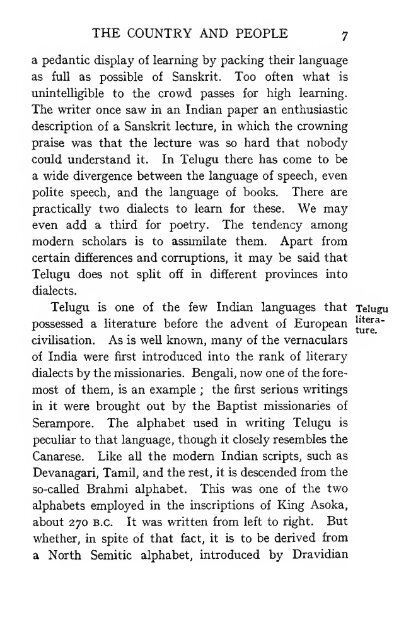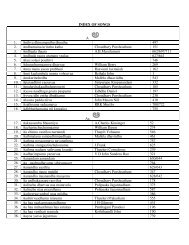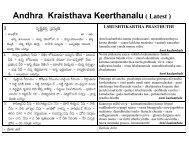Christian missions in the Telugu country - Uecf.net
Christian missions in the Telugu country - Uecf.net
Christian missions in the Telugu country - Uecf.net
You also want an ePaper? Increase the reach of your titles
YUMPU automatically turns print PDFs into web optimized ePapers that Google loves.
THE COUNTRY AND PEOPLE 7<br />
a pedantic display of learn<strong>in</strong>g by pack<strong>in</strong>g <strong>the</strong>ir language<br />
as full as possible of Sanskrit. Too often what is<br />
un<strong>in</strong>telligible to <strong>the</strong> crowd passes for high learn<strong>in</strong>g.<br />
The writer once saw <strong>in</strong> an Indian paper an enthusiastic<br />
description of a Sanskrit lecture, <strong>in</strong> which <strong>the</strong> crown<strong>in</strong>g<br />
praise was that <strong>the</strong> lecture was so hard that nobody<br />
could understand it. In <strong>Telugu</strong> <strong>the</strong>re has come to be<br />
a wide divergence between <strong>the</strong> language of speech, even<br />
polite speech, and <strong>the</strong> language of books. There are<br />
practically two dialects to learn for <strong>the</strong>se. We may<br />
even add a third for poetry. The tendency among<br />
modern scholars is to assmiilate <strong>the</strong>m. Apart from<br />
certa<strong>in</strong> differences and corruptions, it may be said that<br />
<strong>Telugu</strong> does not split off <strong>in</strong> different prov<strong>in</strong>ces <strong>in</strong>to<br />
dialects.<br />
<strong>Telugu</strong> is one of <strong>the</strong> few Indian languages that <strong>Telugu</strong><br />
possessed a literature before <strong>the</strong> advent of European ''t^^a-<br />
civUisation. As is weU known, many of <strong>the</strong> vernaculars<br />
of India were first <strong>in</strong>troduced <strong>in</strong>to <strong>the</strong> rank of literary<br />
dialects by <strong>the</strong> missionaries. Bengali, now one of <strong>the</strong> fore-<br />
most of <strong>the</strong>m, is an example ; <strong>the</strong> first serious writ<strong>in</strong>gs<br />
<strong>in</strong> it were brought out by <strong>the</strong> Baptist missionaries of<br />
Serampore. The alphabet used <strong>in</strong> writ<strong>in</strong>g <strong>Telugu</strong> is<br />
peculiar to that language, though it closely resembles <strong>the</strong><br />
Canarese. Like aU <strong>the</strong> modern Indian scripts, such as<br />
Devanagari, Tamil, and <strong>the</strong> rest, it is descended from <strong>the</strong><br />
so-caUed Brahmi alphabet. This was one of <strong>the</strong> two<br />
alphabets employed <strong>in</strong> <strong>the</strong> <strong>in</strong>scriptions of K<strong>in</strong>g Asoka,<br />
about 270 B.C. It was written from left to right. But<br />
whe<strong>the</strong>r, <strong>in</strong> spite of that fact, it is to be derived from<br />
a North Semitic alphabet, <strong>in</strong>troduced by Dravidian




